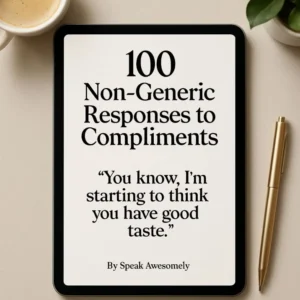Have you ever frozen for a moment when someone asked you, “How’s it going?” It’s one of those everyday greetings that seems simple on the surface but can feel tricky in the moment. Should you give a detailed life update? Keep it short and casual? Or perhaps use it as a chance to build connection?
I still remember when I first moved abroad for my studies. At the local café, the barista would greet me with “How’s it going?” every morning. At first, I would stumble with robotic replies like “Fine, thank you.” But over time, I realised that how you respond can set the tone of an entire conversation. That’s when I started experimenting with answers—sometimes light-hearted, sometimes thoughtful—and the results were surprisingly powerful. Some replies led to deeper conversations, while others simply made the interaction more pleasant.
In this guide, I’ll walk you through the best ways to respond to “How’s it going?”—from casual chats with friends to professional encounters at work. Backed by communication research, real-world examples, and a few personal insights, this article will help you master one of the most common social exchanges with confidence.
Why Your Response Matters More Than You Think
Many people dismiss greetings as mere social fluff, but psychologists disagree. According to a study in the Journal of Social and Personal Relationships, how we engage in small talk can significantly influence how others perceive our warmth and approachability.
Dr. Deborah Tannen, a linguist and professor at Georgetown University, points out that everyday greetings act as “conversational lubricants” that ease us into deeper exchanges. In other words, how you answer “How’s it going?” isn’t just a throwaway—it’s an opportunity to connect, signal positivity, and even build trust.
Think about it: a dull, flat “fine” can close a conversation, while a more thoughtful or playful response can spark curiosity.
Casual Responses for Friends and Everyday Situations
When chatting with friends or acquaintances, your tone can be light and relaxed. Here are some natural responses I’ve tested in real life:
- “Not too bad, just enjoying the day. How about you?”
Simple and balanced—you share a little, then hand the question back. - “Pretty good! I finally started that Netflix series we talked about.”
Personal, specific, and a conversation-starter. - “Honestly? A bit tired, but hanging in there.”
Authentic responses can strengthen bonds, especially with close friends.
A small communication tip: mirroring the energy of the person asking often works best. If a friend greets you casually, match their tone. If they sound upbeat, lean into positivity.
Professional Settings: Staying Polished and Approachable
At work, the same question can carry different weight. It’s not just politeness—it reflects how you’re perceived professionally. Responding well shows emotional intelligence.
Some examples that strike the right balance:
- “Going well, thanks! Just wrapping up a project I’m excited about.”
Adds a positive, work-relevant detail without oversharing. - “Pretty good! Looking forward to the team meeting later.”
Signals enthusiasm and engagement. - “Things are good, thanks. How’s your day been so far?”
Keeps it simple while showing interest in the other person.
According to research from Harvard Business Review, showing genuine interest in others during small talk improves workplace rapport and can enhance perceptions of likeability and collaboration.
Witty and Playful Responses to Keep Things Fun
Sometimes, humour is the best connector. If the context is informal, try light-hearted answers:
- “Better now that coffee’s involved!”
- “Living the dream, as always.”
- “Somewhere between surviving and thriving!”
These playful twists make people smile and invite banter. Just make sure to read the room—humour doesn’t always land in formal contexts.
When You’re Not Doing Well: Honest but Balanced Replies
We all have days when we’re not at our best. Should you admit that when asked “How’s it going?”? The answer depends on who’s asking.
With trusted friends or family, honesty is often appreciated:
- “It’s been a rough week, to be honest, but I’m managing.”
- “Not great, but I appreciate you asking.”
In professional or casual settings, you can stay authentic without oversharing:
- “Could be better, but I’m hanging in there. How about you?”
- “It’s been a busy one, but I’m managing.”
Dr. Laurie Santos, a psychology professor at Yale, suggests that “authentic micro-disclosures” can build trust and deepen social bonds, as long as they are shared in the right context.
Cultural Nuances: Why Context Matters Globally
When I visited Australia, I quickly learnt that “How’s it going?” is often just a casual “hello,” not an invitation for detail. Meanwhile, in some parts of Europe, people may expect a genuine life update.
Understanding cultural context is crucial:
- In the U.S. or Australia → Often a quick greeting, best answered briefly.
- In the U.K. → Responses tend to be modest (*“Not too bad” is common).
- In Mediterranean cultures → Expect more detail and warmth.
This is why being observant helps—mirror the tone and style of the person asking.
Practical Tips to Master Your Responses
- Match Energy → Reflect the other person’s tone and enthusiasm.
- Add a Personal Detail → Makes your answer memorable.
- Keep It Context-Appropriate → Light for casual, polished for professional.
- Pass It Back → Always reciprocate with “And you?” to keep the flow.
- Don’t Overthink It → Sometimes a simple, warm reply is all that’s needed.
Read Also: How to Respond to “Wagwan”: A Complete Guide to Confidence in Modern Conversations
FAQs
Q: Is it rude to just say “good”?
A: Not necessarily—it’s common. But adding a little detail makes it more engaging.
Q: Should I always ask back “And you?”
A: Yes. Reciprocity is polite and shows interest.
Q: What if I don’t want to talk?
A: A brief, polite response like “All good, thanks” works. Body language (smile, nod) helps soften it.
Q: Can humour backfire?
A: Sometimes. Avoid sarcasm in professional or unfamiliar settings.
Final Thoughts
“How’s it going?” may seem like a filler question, but it’s actually a small window into human connection. Whether you choose a light-hearted quip, a professional update, or an honest admission, your reply shapes how others feel about interacting with you.
So next time someone asks, instead of defaulting to “fine,” try adding a touch of personality. Who knows? That simple greeting might spark a meaningful conversation.
💬 I’d love to hear from you—what’s your go-to response to “How’s it going?” Do you prefer keeping it short or using it as a chance to connect? Share your thoughts in the comments below!
Recommended Products

100 First Texts That Always Get a Reply
Original price was: $ 15.$ 5Current price is: $ 5.Add to Cart
All Emoji Meanings Guide (3500+)
Original price was: $ 15.$ 7Current price is: $ 7.Add to Cart
100 Romantic Pick-Up Lines + 20 Bonus 18+ Lines | Modern Dating & Flirting Guide for Confidence, Charm, and Attraction
Original price was: $ 25.$ 10Current price is: $ 10.Add to Cart
100 Witty & Unexpected Responses to Compliments – Speak Awesomely’s Ultimate PDF Guide for Confident, Clever Conversations
Original price was: $ 15.$ 6Current price is: $ 6.Add to Cart









I could not resist commenting. Well written!